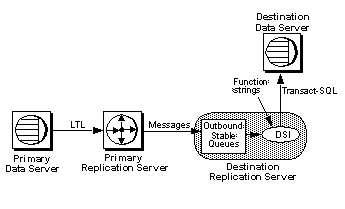Replication Server depends on data servers to provide the transaction-processing services needed to protect stored data. To ensure the integrity of distributed data, data servers must comply with the following transaction-processing conventions:
A transaction is one unit of work. Either all operations in the transaction are performed or none are performed.
Transaction results are permanent. A transaction cannot be arbitrarily undone after it is committed.
Replication Server copies committed transactions from primary sites to destination sites. It distributes transactions in the order they are committed so that copied data passes through the same states as the primary (source) data.
Figure 2-3 illustrates Replication Server’s method for translating transactions.
Figure 2-3: Translating transactions

Once the primary Replication Server sends transactions to subscribing sites, destination Replication Servers store the transactions in the outbound Data Server Interface (DSI) stable queue.